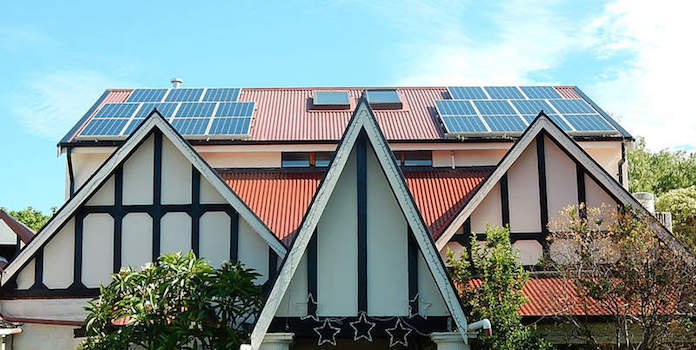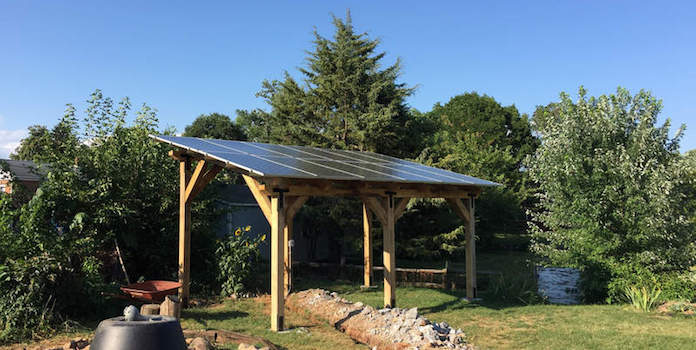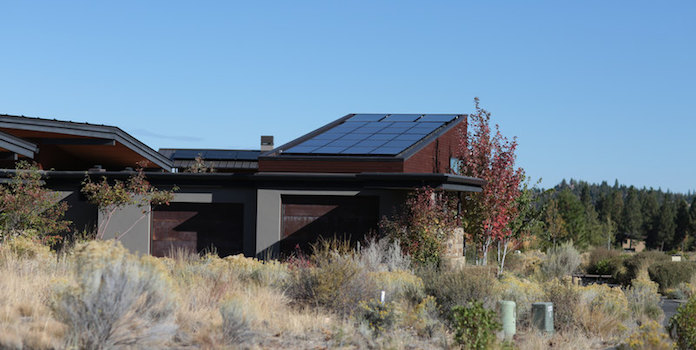How Big and Expensive Is a 4kW Solar System?

Find out how much you could save with a 4kW solar system.
A 4kW installation covers about half of an average home’s electricity use, but what does 4kW really mean? Below, we look at what a 4kW solar system actually is, how much space a 4kW installation takes up on your roof, and how much it costs to install.
Efficiency First!
Before we jump into what a 4kW solar system is, I’m going to tell you a huge secret that could save you big bucks. You might be surprised by this fact, but solar isn’t actually the cheapest way to save money on your electricity bills! What is the cheapest way? Energy efficiency!
Compared to installing solar, you’ll see a higher return on your investment by adopting efficiency measures that reduce your overall electricity use. Before you even think about solar, consider adding insulation to ceilings or crawlspaces, sealing your ductwork, replacing lights with LEDs, and sealing cracks around windows and doors.
In fact, just sealing and insulating your home can drop your energy bills by 5% to 18% depending on your location – pretty amazing!
Once you’ve done all these cost-effective efficiency measures (and by cost-effective, I mean that you’ll make your investment back through energy savings in the not-too-distant future) and dropped your electricity use as low as possible, you’re ready to go solar! You’ll be able to install a smaller, cheaper solar system, allowing you to spend less money and see an even faster return on your solar investment.
Efficiency and solar is like peanut butter and jelly – great on their own, but fantastic when combined!
How Big Is a 4kW Solar System?
Let’s start with the obvious question: how big is a 4kW solar system? Well, let’s look at a few different ways to measure a solar system’s size.
What does 4kW actually mean?
In the solar industry, we talk a lot about kW or kilowatts, but what does it really mean? And how much is 4kW?
Kilowatts simply measures how much electricity something produces or consumes in one moment. You probably don’t think about it, but you’re already familiar with kilowatts. All your light bulbs are rated in watts (1,000 watts = 1kW).
Walk around and look at the top of your bulbs. If they’re LEDs, they probably say something like ‘9 watts’ or ‘9W’. If they’re incandescent bulbs, they probably say something like ‘40W’ or ‘60W’. This is how much electricity they need to turn on and run. Your hair dryer probably needs around 1500 watts. Cell phones typically need around 50 watts to charge.
To measure how much electricity something consumes over time, we use kilowatt-hours. So if you left your phone charging all night, it would consume 400 watts-hours (or 0.4kWh) of electricity (50 watts X 8 hours = 400 watt-hours). If you left your LED light bulb on 24/7, you’d use 6,480 watt-hours (or 6.4kWh) of electricity each month (9 watts X 24 hours X 30 days = 6,480 watt-hours).
Solar installations are different, though. The gadgets above consume electricity. Your solar installation produces electricity. A 4kW installation produces 4kW of electricity (at least, in perfect conditions. In real life, it’s lower due to shading, dirt on the panels, etc). How many kilowatt-hours does a 4kW system produce? It all depends on your location.
Sunlight is strongest at the equator and as you move further away in either direction, it generally gets less and less intense. A well-placed solar installation in Ecuador, at the base of the equator, will produce more electricity than the same exact installation in extreme northern Nunavut, Canada.
Let’s look at a few different cities in the US to see how much electricity a 4kW installation will produce:
- Minneapolis, MN: 5,389 kilowatt-hours annually
- Houston, TX: 5,356 kWh annually
- Hartford, CT: 4,979 kWh annually
The average US household uses about 10,800 kWh each year. As you can see, a 4kW installation will produce roughly half of the electricity an average US household needs.
How many solar panels is that?
Most solar panels for residential installations are around 265 watts, providing a good balance between efficiency and cost. Wattage can be as low as 240 watts for cheaper panels to over 300 watts for the more expensive options. The vast majority of homeowners though find that standard 265 watt panels (or panels with wattage somewhere around there) suit their needs just fine.
If you installed 265 watt panels for your 4kW installation, you’d need 16 panels (4,000 watts / 265 watts = 15.09, rounded up to 16 panels). If you used premium 300-watt panels, you’d only need 14 panels.
Unless you have limited space on your roof, you’re probably better off financially to install the standard, lower-efficiency option. And with a 4kW installation being relatively small, most homes have plenty of roof space to accommodate.
How much space does that take on my roof?
Residential solar panels are typically 5 feet tall by 3 feet wide, with a footprint of 15 square feet. 16 panels would have a footprint of 240 square feet. How big is 24 square feet? Well, it’s about the size of a small, one car garage.
Most people probably wouldn’t have any issues fitting that somewhere on their roof. If for some reason you do have an incredibly small roof, you could always look into higher efficiency panels to cut down on needed space.
How Expensive Is a 4kW Solar System?
The next thing you probably want to know is how much a 4kW installation will set you back. The National Renewable Energy Lab studied installation costs for residential solar in 2016 and found the average cost for residential solar to be around $3 per watt.
Using this amount, we estimate that a 4kW installation costs about $12,000. If you own the installation (paying through either cash or a loan), you’re also eligible for the 30% federal tax credit, dropping your total installation cost to $8,400 (since you’ll avoid paying $3,600 in taxes the following year thanks to the credit).
Experts estimate that solar installations will last around 25 years, so how much does this total installation cost compare to purchasing electricity from your utility? Let’s find out.
First, averaging out the annual production for the 3 locations above, we find that your installation will likely produce around 119,185 kWh over its 25-year life (after accounting for the solar panels’ 0.8% drop in production each year due to aging).
Now let’s break down that cost and find your $ per kWh cost, which will allow us to compare your costs to the utility. Dividing $8,400 by 119,185 kWh, we find your costs will be around $0.07 per kWh.
With the average US utility charging $0.13 per kWh – and that price rising 2.6% each year on average – you’ll be immediately saving money pretty much anywhere you install (as long as your utility offers net metering). In fact, many states, local governments, and utilities offer tax credits, rebates, and other incentives to further drop your installation price, allowing you to save even more money.
At this rate, you’re on track to save around $12,800 over the life of your installation!
So if you’re thinking about installing a 4kW solar system, reach out to a few installers and see what your savings could be. It’s a fairly small system, but you might be surprised by how much you can actually save!
Do you have a small system? Let us know what size and what kind of savings you enjoy in the comments below!


